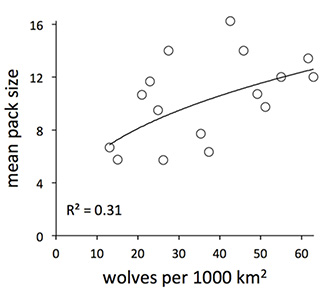
Ecological Archives E096-007-A3
Alessia Uboni, John A. Vucetich, Daniel R. Stahler, and Douglas W. Smith. 2015. Interannual variability: a crucial component of space use at the territory level. Ecology 96:62–70. http://dx.doi.org/10.1890/13-2116.1
Appendix C. Mean pack size tends to increase with total population density for the Northern Range wolf population (1996–2011).
Fig. C1. Mean pack size tends to increase with total population density for the Northern Range wolf population (1996–2011, p = 0.04). The curve represents this relationship: pack size = 2.56density0.39. Pack size and density are related for some other wolf populations, for example, Upper Michigan [p < 0.01 (Roell et al. 2010)] and Isle Royale [p < 0.01, (Vucetich, unpublished data)]. In some cases, the influence of pack size on density also requires taking into account the number of packs in the population (e.g., Wisconsin [p = 0.06 for pack size and p < 10-7 for number of packs in the population, (Wydeven et al. 2009)]). In other cases, the relationship is Ç-shaped (i.e., Montana, [p < 0.01 (Hanauska-Brown et al. 2012)]).
Literature cited
Hanauska-Brown, L., L. Bradley, J. Gude, N. Lance, K. Laudon, A. Messer, A. Nelson, M. Ross, and J. Steuber. 2012. Montana Gray Wolf Conservation and Management 2011 Annual Report. Montana Fish, Wildlife & Parks, Helena, Montana.
Roell, B. J., D. E. Beyer Jr, P. E. Lederle, D. H. Lonsway, and K. L. Sitar. 2010. Michigan Wolf Management 2009 Report. Michigan Department of Natural Resources and Environment. Wildlife Division Report.
Wydeven, A. P., J. E. Wiedenhoeft, R. N. Schultz, R. P. Thiel, R. L. Jurewicz, B. E. Kohn, and T. R. Van Deelen. 2009. History, population growth, and management of wolves in Wisconsin. Pages 87–105 in A. P. Wydeven, T. R. Van Deelen, and E. J. Heske, editors. Recovery of gray wolves in the Great Lakes region of the United States: An endangered species success story. Springer, New York, New York, USA.